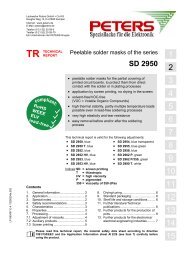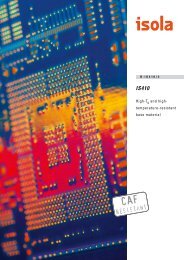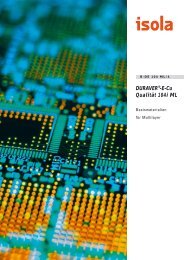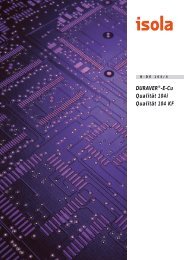ISOLA Duraver-E-Cu quality 104
ISOLA Duraver-E-Cu quality 104
ISOLA Duraver-E-Cu quality 104
You also want an ePaper? Increase the reach of your titles
YUMPU automatically turns print PDFs into web optimized ePapers that Google loves.
Technical data<br />
DURAVER ® -E-<strong>Cu</strong> <strong>quality</strong> <strong>104</strong>, -<strong>104</strong> KF, -<strong>104</strong> TS<br />
Data sheet No.: IPC-4101/21<br />
Core material: E-glass fabric<br />
Resin system: Epoxy, flame retardant<br />
UL-File No.: E41625, V-0 acc. to 94<br />
Explanations:<br />
C = preconditioning in humidity chamber<br />
E = preconditioning at temperature<br />
The figures following the letter symbols indicate<br />
with the first digit the duration of the<br />
preconditioning in hours, with the second<br />
digit the preconditioning temperature in °C<br />
and with the third digit the relative humidity.<br />
Properties Unit Specification<br />
≥ 0.78 mm<br />
1. Peel Strength, minimum<br />
A. Low profile copper foil and very low<br />
profile copper foil - all copper<br />
weights > 17 microns N/mm –<br />
B. Standard profile copper foil (35 microns)<br />
1. After thermal stress N/mm 1.05<br />
2. At 125 °C N/mm 0.70<br />
3. After process solutions N/mm 0.80<br />
C. All other foil-composite N/mm –<br />
2. Volume Resistivity, minimum<br />
A. C-96/35/90 MΩ · cm –<br />
B. After moisture resistance MΩ · cm 1.0 · 10 6<br />
C. At elevated temperature E-24/125 MΩ · cm 1.0 · 10 3<br />
3. Surface Resistivity, minimum<br />
A. C-96/35/90 MΩ –<br />
B. After moisture resistance MΩ 1.0 · 10 4<br />
C. At elevated temperature E-24/125 MΩ 1.0 · 10 3<br />
4. Moisture Absorption, maximum % 0.35<br />
5. Dielectric Breakdown, minimum kV 40<br />
6. Permittivity @ 1 MHz, maximum 5.4<br />
7. Loss Tangent @ 1 MHz, maximum 0.035<br />
8. Flexural Strength, minimum<br />
A. Length direction N/mm 2 415<br />
B. Cross direction N/mm 2 345<br />
9. Flexural Strength @ Elevated Temperature<br />
length direction, minimum N/mm 2 –<br />
10. Thermal Stress @ 288 °C, minimum<br />
A. Unetched s ≥ 10<br />
B. Etched s ≥ 10<br />
11. Electric Strength, minimum V/mm –<br />
12. Flammability<br />
A. Average burn time, maximum s 5<br />
B. Individual burn time, maximum s 10<br />
13. Glass Transition Temperature (T g ) DSC °C –<br />
14. Coefficient of Thermal Expansion (α) TMA<br />
Weft direction (below T g /above T g ) ppm/K –<br />
Warp direction (below T g /above T g ) ppm/K –<br />
Vertical (below T g /above T g ) ppm/K –<br />
All the data contained in this technical information have been carefully compiled. In view of the variety of conditions prevailing in practice, as well as<br />
the different process and application technologies used, the data and information contained herein can only serve as guideline values and do not give<br />
rise to any rights under warranty terms.<br />
6








